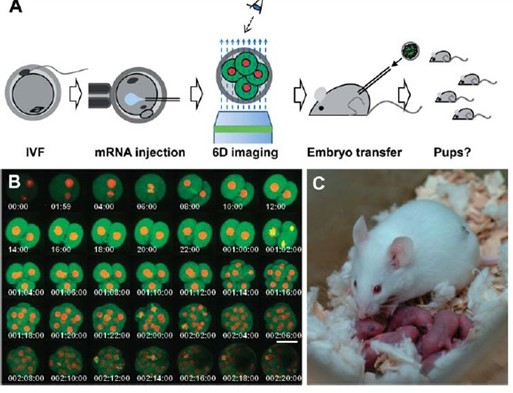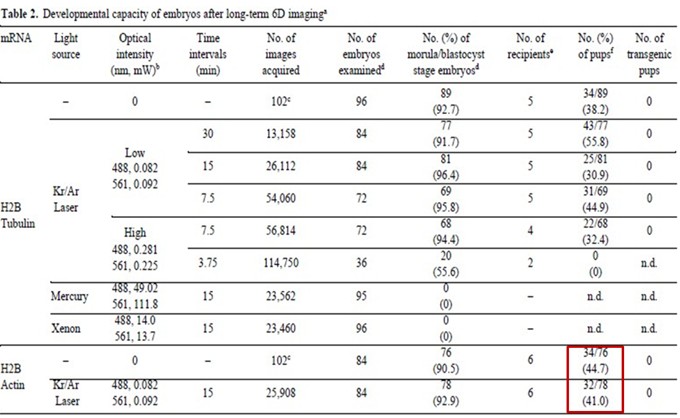Long-term, 6D live cell observation of mouse embryos
The coordination of mammalian cell embryo implantation development and temporal space is inseparable. Therefore, the analysis of these developmental processes must also be real-time, dynamic and 3D. The fluorescent protein expression techniques we used in the past, mRNA microinjection and time-phase fluorescence microscopy made live cell imaging possible, but the data obtained by traditional fluorescence microscopy could not be used to construct three-dimensional conformation due to fluorescence microscopy. The thickness of the embryo cannot be transmitted and the fluorescence interference of the non-focal plane cannot be overcome. Moreover, repeated irradiation with strong fluorescence can also be phototoxic to embryonic cells, so long-term dynamic observation has become a bottleneck in embryo development analysis.
The article we introduced today improves the imaging system so that confocal imaging devices (using Yokogawa confocal scanning devices) can get 6D data (x, y, z, t, λ, s), and importantly, improved Imaging equipment and imaging conditions made long-term fluorescence observations without any effect on embryonic development. Taking the data from our experiments as an example, the embryos received two wavelengths of fluorescence excitation during the 70-hour observation period - 488 and 561 (each time interval was 7.5 minutes), each time point 51 Z-axis tomograms were taken; therefore we shot a total of 56,814 fluorescent photos. However, such frequent fluorescence exposure did not affect the development of the embryo. All embryos were implanted into surrogate mothers to produce healthy mice that were not genetically modified and had normal reproductive capacity. Therefore, our improved live cell observation system is completely safe and non-toxic to long-term multi-phase mouse embryo development. This technique can also be applied to other embryo development fields, such as human reproductive technology and animal reproduction research. The design and results of the experiment are as follows:

Firstly, the mRNAs of EGFP-α-tubin and H 2 B-mRFP were microinjected and injected into the in vitro fertilized embryonic cells, and the embryos were observed to the blastocyst stage by live cell fluorescence imaging and then transferred to pseudopregnant mothers (A). Embryonic cells were imaged in vitro prior to embryo transfer, and dynamic changes in typical spindle (GFP, green) and nucleus (RFP, red) were observed (B), and 51 Z-axes were taken at each time point. The faults were superimposed on a picture for display; after 70 hours of shooting, the mouse embryos of the blastocyst stage were transferred to pseudo-pregnant mothers, and the mouse embryos that had been irradiated with fluorescence developed into healthy mice with normal reproductive ability. Group (C).
In the design of the experiment, the researchers set up a non-fluorescent irradiation control group, and also used a variety of observation parameters in the process of living cell imaging, such as adjusting the fluorescence intensity, observing the time interval, and finding the most suitable for embryo observation. Condition setting----7.5min interval, 488nm-0.082mW, 561nm-0.092Mw. Then, this set of parameters was applied to H2B, ACTIN was also red-green fluorescently labeled mouse embryos, and the embryo survival rate of the control group (no fluorescence irradiation group) and the experimental group (fluorescence observation group) was roughly before and after embryo transfer. Rather, it is stated that this set of parameters, as well as the improved live cell imaging system, have minimized the toxicity of fluorescent exposure, with no difference from non-fluorescent illumination (red boxing).

Antifungal drug: A drug used to treat fungal infections(antimicrobial drugs).
Examples of antifungal drugs include miconazole and clotrimazole.
An antifungal medication is a pharmaceutical fungicide used to treat and prevent mycoses such as athlete's foot, ringworm, candidiasis (thrush), serious systemic infections such as cryptococcal meningitis, and others. Such drugs are usually obtained by a doctor's prescription, but a few are available OTC (over-the-counter).
Antifungal Drugs,Griseofulvin Drugs,Clotrimazole Drugs
NOUVASANT PHARMhealth LTD. , https://www.nouvasant.com